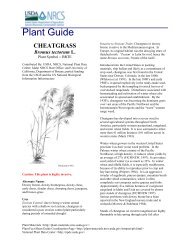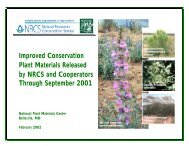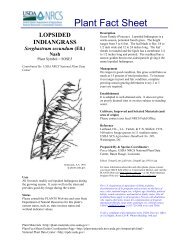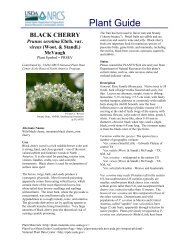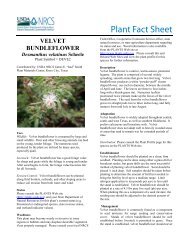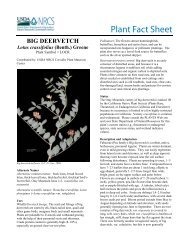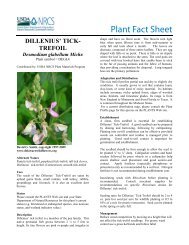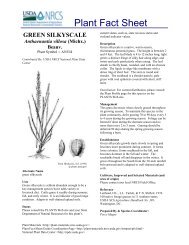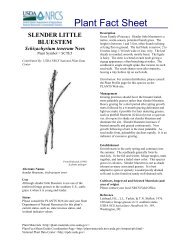Plant Guide - USDA Plants Database - US Department of Agriculture
Plant Guide - USDA Plants Database - US Department of Agriculture
Plant Guide - USDA Plants Database - US Department of Agriculture
You also want an ePaper? Increase the reach of your titles
YUMPU automatically turns print PDFs into web optimized ePapers that Google loves.
SPICEB<strong>US</strong>H<br />
Lindera benzoin (L.) Blume<br />
var. pubescens (Palmer &<br />
Steyermark) Rehd.<br />
<strong>Plant</strong> Symbol = LIBEP<br />
Contributed by: <strong><strong>US</strong>DA</strong> NRCS National <strong>Plant</strong> Data<br />
Center & the Biota <strong>of</strong> North America Program<br />
William S. Justice<br />
Botany Dept., NMNH, Smithsonian Institution<br />
@ PLANTS<br />
Alternate Names<br />
Northern spicebush, benjaminbush<br />
Uses<br />
Over 20 species <strong>of</strong> birds, as well as deer, rabbits,<br />
raccoons, and opossums, have been recorded as<br />
browsing the leaves or eating the fruits. The fruits<br />
are a special favorite <strong>of</strong> wood thrushes. The<br />
spicebush swallowtail, Papilio troilus (L.), lays its<br />
eggs on spicebush and other plants in the Laurel<br />
Family – sassafras, redbay, and camphortree.<br />
There apparently are no commercial uses <strong>of</strong><br />
spicebush, but the essential oils <strong>of</strong> leaves, twigs, and<br />
fruits have lent themselves for minor use for tea, and<br />
dried fruits have been used in fragrant sachets.<br />
Native Americans used dried fruits as a spice and the<br />
leaves for tea. Extracts have been used for drugs,<br />
including anti-arthritic, diaphoretic, emetic and<br />
herbal steam. The benzoin <strong>of</strong> drug trade is produced<br />
by species <strong>of</strong> Styrax (Styraceae).<br />
Because <strong>of</strong> its habitat in rich woods, early land<br />
surveyors and settlers used spicebush as an indicator<br />
species for good agricultural land.<br />
<strong>Plant</strong> <strong>Guide</strong><br />
Spicebush plants make nicely shaped shrubs with<br />
deep green leaves, and if in at least partial sun, the<br />
leaves turn bright yellow in the fall. It is a good<br />
choice for plantings in shady locations but can also<br />
grow in full sun. Moist soil is best. The species is<br />
now becoming available through many commercial<br />
nurseries.<br />
Status<br />
Please consult the PLANTS Web site and your State<br />
<strong>Department</strong> <strong>of</strong> Natural Resources for this plant’s<br />
current status, such as, state noxious status and<br />
wetland indicator values.<br />
Description<br />
General: Laurel Family (Lauraceae). Native shrubs,<br />
mostly growing 1-3(-5) meters tall, sometimes a<br />
small tree; reproducing asexually by root sprouting<br />
(most spicebush patches and thickets are probably<br />
clonal). Leaves are thin, deciduous, glabrous or<br />
sparsely pubescent on the lower surface, obovate to<br />
oblong or elliptic, 6-14 cm long, pointed at both ends,<br />
entire, on petioles 5-12 mm long, usually largest at<br />
the branch tips, decreasing in size down the branch.<br />
Flowers appearing before the leaves, in clusters on<br />
nodes <strong>of</strong> last year’s growth, either staminate (pollenproducing),<br />
with 9 fertile stamens, or pistillate (with<br />
a fertile ovary and 12-18 rudimentary, infertile<br />
stamens), both types with 6 short, yellowish sepals,<br />
the female and male on different plants (the species<br />
dioecious). Fruit a short-stalked, ellipsoid, shiny-red<br />
berry 6-10 mm long, with a single seed. The<br />
common name refers to the sweet, spicy fragrance <strong>of</strong><br />
the stems, leaves, and fruits when bruised.<br />
Variation within the species: Lindera benzoin var.<br />
pubescens (Palmer & Steyermark) Rehd. is the more<br />
southern form <strong>of</strong> the species, absent from the<br />
northernmost states <strong>of</strong> the species range, with twigs<br />
and lower leaf surfaces hairy (vs. glabrous in var.<br />
benzoin). Var. benzoin does not occur in the states<br />
directly bordering the Gulf <strong>of</strong> Mexico.<br />
Two closely related species (the only other species <strong>of</strong><br />
the genus in North America) occur in the<br />
southeastern <strong>US</strong>, where they are rare throughout their<br />
range –– Lindera melissifolia (Walt.) Blume,<br />
pondberry or southern spicebush, and Lindera<br />
subcoriacea B.E. W<strong>of</strong>ford, bog spicebush. Allozyme<br />
studies <strong>of</strong> populations <strong>of</strong> spicebush and pondberry<br />
show that both species have low levels <strong>of</strong> genetic<br />
diversity.<br />
<strong>Plant</strong> Materials <br />
<strong>Plant</strong> Fact Sheet/<strong>Guide</strong> Coordination Page <br />
National <strong>Plant</strong> Data Center
Distribution<br />
Spicebush occurs over all <strong>of</strong> the eastern <strong>US</strong>, from<br />
east Texas, Oklahoma, and Kansas eastward to the<br />
Atlantic states as far north as Maine (and Ontario),<br />
not reported from Wisconsin. For current<br />
distribution, please consult the <strong>Plant</strong> Pr<strong>of</strong>ile page for<br />
this species on the PLANTS Web site.<br />
Adaptation<br />
Spicebush is primarily an understory species,<br />
sometimes forming thickets, <strong>of</strong> rich, mesic sites on<br />
acidic to basic soils. Common habitats are low<br />
woods, swamp margins, and streamsides. Flowering<br />
March-April; fruits maturing August-October (-<br />
November).<br />
Establishment<br />
Seeds are dispersed as animals and birds eat the<br />
fruits. Seeds germinate in the litter layer in the spring<br />
or they may remain viable in the seed bank for many<br />
years. Much <strong>of</strong> the reproduction is clonal through<br />
root sprouting.<br />
Management<br />
Spicebush successfully grows and reproduces in a<br />
wide range range <strong>of</strong> light conditions. Although it<br />
does grow and reproduce under completely closed<br />
canopy, openings in the canopy increase growth rate.<br />
It is considered difficult to transplant but has few<br />
serious disease problems.<br />
Cultivars, Improved and Selected Materials (and<br />
area <strong>of</strong> origin)<br />
These plant materials are readily available from<br />
commercial sources. Contact your local Natural<br />
Resources Conservation Service (formerly Soil<br />
Conservation Service) <strong>of</strong>fice for more information.<br />
Look in the phone book under ”United States<br />
Government.” The Natural Resources Conservation<br />
Service will be listed under the subheading<br />
“<strong>Department</strong> <strong>of</strong> <strong>Agriculture</strong>.”<br />
References<br />
Carter, M. & P. Feeny 1999. Host-plant chemistry<br />
influences oviposition choice <strong>of</strong> the spicebush<br />
swallowtail butterfly. J. Chem. Ecol. 25:1999-2009.<br />
Cipollini, M.L. & D.F. Whigham 1994. Sexual<br />
dimorphism and cost <strong>of</strong> reproduction in the dioecious<br />
shrub Lindera benzoin (Lauraceae). Amer. J. Bot.<br />
81:65-75.<br />
Cipollini, M.L., Wallace-Senft, D.A., & D.F.<br />
Whigham 1994. A model <strong>of</strong> patch dynamics, seed<br />
dispersal and sex ratio in the dioecious shrub<br />
Lindera benzoin (Lauraceae). J. Ecol. 82:621-633.<br />
Godt, M.J.W. & J.L. Hamrick 1996. Allozyme<br />
diversity in the endangered shrub Lindera<br />
melissifolia (Lauraceae) and its widespread congener<br />
Lindera benzoin. Canad. J. Forest Res. 26:2080-<br />
2087.<br />
McCartney, R.D., K. Wurdack, & J. Moore. 1989.<br />
The genus Lindera in Florida. Palmetto 9:3-8.<br />
Tucker, A.O., M.J. Maciarello, P.W. Burbage, & G.<br />
Sturtz 1994. Spicebush (Lindera benzoin (L.) Blume<br />
var. benzoin, Lauraceae): A tea, spice, and medicine.<br />
Econ. Bot. 48:333-336.<br />
W<strong>of</strong>ford, B.E. 1983. A new Lindera from North<br />
America. J. Arnold Arbor. 64:325-331.<br />
W<strong>of</strong>ford, B.E. Lindera. Pp. 27-29, IN: Flora <strong>of</strong><br />
North America, North <strong>of</strong> Mexico. Vol. 3. Oxford<br />
Univ. Press, New York.<br />
<br />
Prepared By<br />
Guy Nesom<br />
Formerly BONAP, North Carolina Botanical Garden,<br />
University <strong>of</strong> North Carolina, Chapel Hill, North<br />
Carolina<br />
Species Coordinator<br />
Gerald Guala<br />
<strong><strong>US</strong>DA</strong>, NRCS, National <strong>Plant</strong> Data Center, Baton<br />
Rouge, Louisiana<br />
Edited: 05dec00 jsp;05feb03ahv; 060802 jsp<br />
For more information about this and other plants, please contact<br />
your local NRCS field <strong>of</strong>fice or Conservation District, and visit the<br />
PLANTS Web site or the <strong>Plant</strong> Materials<br />
Program Web site <br />
The U.S. <strong>Department</strong> <strong>of</strong> <strong>Agriculture</strong> (<strong><strong>US</strong>DA</strong>) prohibits<br />
discrimination in all its programs and activities on the basis <strong>of</strong><br />
race, color, national origin, sex, religion, age, disability, political<br />
beliefs, sexual orientation, and marital or family status. (Not all<br />
prohibited bases apply to all programs.) Persons with disabilities<br />
who require alternative means for communication <strong>of</strong> program<br />
information (Braille, large print, audiotape, etc.) should contact<br />
<strong><strong>US</strong>DA</strong>'s TARGET Center at 202-720-2600 (voice and TDD).<br />
To file a complaint <strong>of</strong> discrimination write <strong><strong>US</strong>DA</strong>, Director, Office<br />
<strong>of</strong> Civil Rights, Room 326-W, Whitten Building, 14th and<br />
Independence Avenue, SW, Washington, DC 20250-9410 or call<br />
202-720-5964 (voice or TDD). <strong><strong>US</strong>DA</strong> is an equal opportunity<br />
provider and employer.
Read about Civil Rights at the Natural Resources Convervation<br />
Service.



